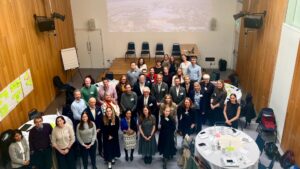Four Steps Towards Fiscal Openness
Making fiscal information more readily available and increasing participation in fiscal policy can significantly benefit both governments and the public. Open budgets lead to lower deficits, more targeted budget priorities, increased operational efficiency, higher tax morale, and increased revenue. However, the 2023 Open Budget Survey reveals that many countries still lack meaningful opportunities for people to get involved in fiscal policy.
Spurred by fiscal openness reforms undertaken by the Scottish Government and becoming one of the most important policy areas in the Open Gov Challenge, OGP’s Nordic+ group has met on several occasions in Scotland and online during Open Gov Week to discuss how to advance fiscal transparencyAccording to OGP’s Articles of Governance, transparency occurs when “government-held information (including on activities and decisions) is open, comprehensive, timely, freely available to the pub... More and enhance participation in fiscal policy. From these discussions, four key lessons stood out.
Transparency portals must become more accessible and understandable.
Both data holders and users have realized that making data available is not enough. Yes, if data is published, it needs to adhere to open dataBy opening up data and making it sharable and reusable, governments can enable informed debate, better decision making, and the development of innovative new services. Technical specifications: Polici... principles. However, it is also crucial to know who will use the data, how, and for what purpose to move beyond transparency for transparency’s sake.
- Among others, Scotland, Lithuania, and the Netherlands are currently rethinking their fiscal transparency portals to ease understanding of fiscal information. They are focusing on identifying their target users and how these users need to interact with the data. This involves creating visualizations and simplifying information for the average person, while also ensuring the portal is useful for more tech-savvy and professional users.
Data must be useful across portals and for different stakeholders.
Understandably, data holders often publish their information in a way that is convenient for them, without considering the quality of data, the type of information, and data formats that users might need. These users could be civil society actors and journalists trying to piece together information about budgetary and spending data. Public sector institutions themselves also face challenges in which their data varies greatly, requiring significant efforts to link datasets from different government sources. Establishing common data standards across levels and branches of government helps to avoid these issues down the road.
- Comparative research between Scottish and Lithuanian procurement data related to infrastructure projects reveals significant levels of data fragmentation and accessibility challenges. These challenges can be overcome through the use of CoST tools and standards such as IDS and OC4IDS that ensure interoperability among various systems and portals, improve underlying data, and establish clear links between projects and contracts.
The language we use matters.
As fiscal policy and data can be highly technical, we need to proactively think about how to talk about and present them to ensure comprehension and cohesion. Fortunately, there are a number of tools readily available for that purpose.
- Plain language as an applied concept means that the intended audience can easily find, understand, and use the information they need. Moreover, plain language has the potential to empower the reader and to increase trust. As an example, the Norwegian Tax Administration received fewer complaints and inquiries thanks to a commuter guide in plain language.
- Citizens budgets are a way to present fiscal information to a general audience. While these can be compiled by civil society, it is advisable for governments to make a habit of proactively simplifying and visualizing fiscal information, such as by explaining the economic assumptions underlying the budget as well as information on revenue collection, spending allocations, significant policy initiatives, and beyond.
- Fiscal decisions have real implications on people’s daily lives. Tools such as gender and human rights budgeting can help us assess the impact of budgetary decisions on a myriad of intersectional socio-economic issues.
People should be proactively engaged in fiscal policy.
Not only should we work towards greater public trust towards the government, but the government in turn needs to show trust in its citizens. Fiscal policy is complex, yet experience across participatory examples shows that people take the time to understand and do not shy away from making difficult decisions. Participatory and deliberative interventions can help to achieve greater consensus, thereby increasing the legitimacy of otherwise polarizing decisions and promoting the relevanceAccording to the OGP Articles of Governance, OGP commitments should include a clear open government lens. Specifically, they should advance at least one of the OGP values: transparency, citizen partic... and creativity of solutions. This is especially impactful when these approaches are seamlessly integrated into how the government works.
- To address the perception of limited citizen influence in government decisions, Finland is actively involving its people through initiatives such as the national dialogues model, now also used in Latvia. Finland recently committed to strengthening this model by expanding the number of participants and simplifying the results to better shape public policy-making.
- The Citizens’ Economic Council on the Cost of Living in the UK is an example of a process where citizens had a say on national economic policy issues by addressing how the government should respond to the cost of living crisis. These interventions not only raised awareness among citizens but also offered opportunities for them to see the results of their contributions through follow-up activities and policy choices.
Do these challenges and lessons speak to you? The OGP Nordic+ group is now setting up a learning circle to continue these discussions. If you’re interested in joining, please reach out to [email protected].


Leave a Reply